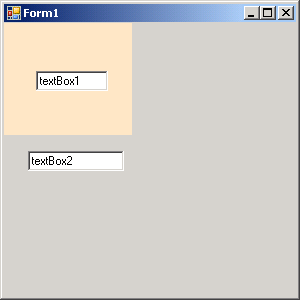Form and Control Click Event

Imports System
Imports System.Drawing
Imports System.Windows.Forms
public class MainClass
Shared Sub Main()
Dim form1 As Form = New Form1
Application.Run(form1)
End Sub
End Class
Public Class Form1
Inherits System.Windows.Forms.Form
#Region " Windows Form Designer generated code "
Public Sub New()
MyBase.New()
'This call is required by the Windows Form Designer.
InitializeComponent()
'Add any initialization after the InitializeComponent() call
End Sub
'Form overrides dispose to clean up the component list.
Protected Overloads Overrides Sub Dispose(ByVal disposing As Boolean)
If disposing Then
If Not (components Is Nothing) Then
components.Dispose()
End If
End If
MyBase.Dispose(disposing)
End Sub
Friend WithEvents ctl1 As System.Windows.Forms.Control
Friend WithEvents textBox1 As System.Windows.Forms.TextBox
Friend WithEvents textBox2 As System.Windows.Forms.TextBox
'Required by the Windows Form Designer
Private components As System.ComponentModel.IContainer
'NOTE: The following procedure is required by the Windows Form Designer
'It can be modified using the Windows Form Designer.
'Do not modify it using the code editor.
<System.Diagnostics.DebuggerStepThrough()> Private Sub InitializeComponent()
Me.ctl1 = New System.Windows.Forms.Control()
Me.textBox1 = New System.Windows.Forms.TextBox()
Me.textBox2 = New System.Windows.Forms.TextBox()
Me.ctl1.SuspendLayout()
Me.SuspendLayout()
'
'ctl1
'
Me.ctl1.BackColor = System.Drawing.Color.Bisque
Me.ctl1.Controls.AddRange(New System.Windows.Forms.Control() {Me.textBox1})
Me.ctl1.Name = "ctl1"
Me.ctl1.Size = New System.Drawing.Size(128, 112)
Me.ctl1.TabIndex = 0
'
'textBox1
'
Me.textBox1.Location = New System.Drawing.Point(32, 48)
Me.textBox1.Name = "textBox1"
Me.textBox1.Size = New System.Drawing.Size(72, 20)
Me.textBox1.TabIndex = 1
Me.textBox1.Text = "textBox1"
'
'textBox2
'
Me.textBox2.Location = New System.Drawing.Point(24, 128)
Me.textBox2.Name = "textBox2"
Me.textBox2.Size = New System.Drawing.Size(96, 20)
Me.textBox2.TabIndex = 1
Me.textBox2.Text = "textBox2"
'
'Form1
'
Me.AutoScaleBaseSize = New System.Drawing.Size(5, 13)
Me.ClientSize = New System.Drawing.Size(292, 273)
Me.Controls.AddRange(New System.Windows.Forms.Control() {Me.textBox2, Me.ctl1})
Me.Name = "Form1"
Me.Text = "Form1"
Me.ctl1.ResumeLayout(False)
Me.ResumeLayout(False)
End Sub
Private Sub Form1_Load(ByVal sender As System.Object, ByVal e As System.EventArgs) Handles MyBase.Load
End Sub
#End Region
Private Sub Form1_Click(ByVal sender As Object, ByVal e As System.EventArgs) Handles MyBase.Click
Console.WriteLine(Me.ClientRectangle.ToString)
End Sub
Private Sub ctl1_Click(ByVal sender As System.Object, ByVal e As System.EventArgs) Handles ctl1.Click
Console.WriteLine(ctl1().ClientRectangle.ToString)
End Sub
End Class
Related examples in the same category